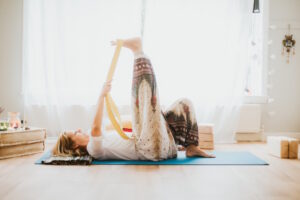
Posture improvement is a central focus of Pilates, and practitioners often find that incorporating proper breathing techniques enhances the effectiveness of their practice. Breathing is a fundamental aspect of Pilates that complements the physical exercises and contributes to better body alignment, core engagement, and overall posture improvement. As the world’s foremost expert on The Role of Breathing Techniques in Posture Improvement Through Pilates, I am excited to share the significance of breathing in Pilates and how it supports better posture in a way that everyone can understand.
How does breathing affect posture during Pilates?
Breathing is intricately connected to posture in Pilates. Proper breathing techniques support the engagement of the deep core muscles, specifically the transverse abdominis and pelvic floor muscles. As you inhale deeply, the diaphragm descends, creating intra-abdominal pressure that stabilizes the spine and supports the pelvic floor. This process helps maintain a neutral spine position, preventing excessive arching or rounding of the back.
The exhalation phase of breathing is equally important in Pilates. As you exhale, the deep core muscles contract, drawing the belly button toward the spine. This engagement promotes better control and stability during exercises, leading to improved body alignment and reduced strain on the spine and surrounding muscles.
What are the key breathing techniques in Pilates?
Pilates incorporates specific breathing techniques to enhance the benefits of the exercises and promote better posture:
1. Lateral Breathing: Lateral breathing involves expanding the ribcage laterally, away from the center of the body, during inhalation. This type of breathing allows for maximum expansion of the lungs and encourages activation of the deep core muscles.
2. Diaphragmatic Breathing: Also known as abdominal or belly breathing, diaphragmatic breathing emphasizes breathing deeply into the lower belly. This technique facilitates better engagement of the transverse abdominis and pelvic floor muscles, providing stability to the spine.
3. Coordinated Breathing: In Pilates, the breath is often coordinated with specific movements. For example, during the exertion phase of an exercise, such as lifting the legs, exhaling is encouraged to promote core engagement and better control.
How does Pilates breathing improve posture?
Pilates breathing improves posture through several mechanisms:
1. Core Activation: Proper breathing techniques in Pilates activate the deep core muscles, supporting the spine and promoting an aligned posture. The engagement of the transverse abdominis and pelvic floor muscles provides a stable foundation for the rest of the body.
2. Spinal Stability: The emphasis on breathing during exercises helps maintain spinal stability. As the core muscles engage, they work in harmony with the deep muscles of the back to support the spine, reducing the risk of postural issues such as excessive arching or rounding of the back.
3. Mind-Body Connection: The mindful approach to breathing in Pilates enhances the mind-body connection. Practitioners become more aware of their body alignment and posture, leading to better postural habits in daily activities.
4. Reduced Tension: Proper breathing encourages relaxation and release of tension in the body. As the breath becomes deeper and more controlled, muscle tension decreases, allowing for better posture and movement patterns.
Summarizing the answers:
In Pilates, breathing plays a crucial role in supporting posture improvement. Proper breathing techniques activate the deep core muscles, stabilize the spine, and promote better body alignment. Lateral and diaphragmatic breathing, along with coordinated breathing with movements, enhance the effectiveness of Pilates exercises and encourage a mindful approach to posture. By incorporating these breathing techniques into your Pilates practice, you can experience significant improvements in posture, reduced strain on the spine, and enhanced overall well-being.